One Step Backward, Two Steps Forward
Mid- and full-size sport-utility vehicles are staging a modest comeback after seemingly destined for extinction in 2008, devastated by soaring gas prices and a crashing global economy. Since then, pump prices are much less of an issue and the U.S. economy is on a high note. That’s opened the door for families who need a seven- or eight-passenger SUV for a wide variety of reasons.
Mixed among today’s 20-some midsize utes is the 2017 Nissan Pathfinder, a new old school vehicle in design and execution.
The Backstory
Born in 1986, the Pathfinder was a two-door SUV with a definite muscular, almost macho appearance. It had to. It was going up against the big brutes from Detroit—Ford Bronco, Jeep Cherokee and Chevrolet Blazer. It also had to contend with the proven and rugged looking Toyota Land Cruiser.

Then the market changed. Important off-road features such as ground clearance, suspension travel and break-over angle were no longer relevant to the buying decision. Instead, purchases were based on a smooth ride, the sound system and the number of cup holders. Under those conditions, a new, larger four-door Pathfinder was launched in the fall of 1995 to meet the demands of the new customer. The rugged styling was brushed away in favor of a more modern, smoother look. Under the new skin, a unit-body structure replaced the truck style body-on-frame construction and provided car-like ride and handling.
Nissan unveiled a completely redesigned Pathfinder for the 2005 model year, which grew larger and more capable while morphing back from unit-body to its original body-on-frame configuration. While this change gave the new SUV some off-road cred again, a full independent suspension offered both a comfortable and confident ride in basic cruising mode. Adding to the allure of this new Pathfinder was standard third-row seating.
Apparently Nissan has a difficult time figuring out the midsize SUV market because in 2013 an all-new Pathfinder once again moved away from a body-on-frame, truck-based SUV and adopted a unit-body design. Following other Nissan models, the Pathfinder employed a continuously-variable transmission (CVT), mimicked European rounded styling and added a few needed inches for the third row.
That brings us to the 2017 Pathfinder.
One Step Backwards
A 2017 mid-cycle update takes a styling step backwards a bit. But only a bit. Instead of a rounded, swept back appearance, Nissan has given the Pathfinder squared off edges to make it look more like the SUV it used to be. This all translates to more well-defined approach angles at the front and rear and to burlier fenders along with a new “V-Motion” grille design flanked by “boomerang” headlamps with LED daytime running lights under a taller, sleeker hood.

At the rear are new bumper and taillights, squared off straight edges on the rear hatch and a new foot-activated lift gate… for when your hands are full… but your feet are free. Somehow the styling change resulted in better aerodynamics for the Pathfinder, with Nissan saying it moved from 0.34 Cd to a coefficient of just 0.326. While less drag aids fuel economy, the overall result of the new look is the Pathfinder now stands out in traffic.
First Step Forward
No midterm update is complete without new interior features, and this is where the 2017 Pathfinder takes its first step forward. All four trim levels—S, SV, SL, Platinum—have an eight-inch touchscreen with new connectivity features and a new drive-assist display between the gauges now standard with. Besides the larger touchscreen, the base S adds Bluetooth, a rearview camera, SiriusXM satellite radio and a second USB port. Standard equipment on the SV remains the same, but a new Tech package brings navigation, blind-spot warning, and rear cross-traffic alert to this model. The SL now includes the 360-degree-view monitor with new moving-object detection and a metallic interior trim. The top Platinum level adds adaptive cruise control, which brings with it forward-collision warning and automated emergency braking.
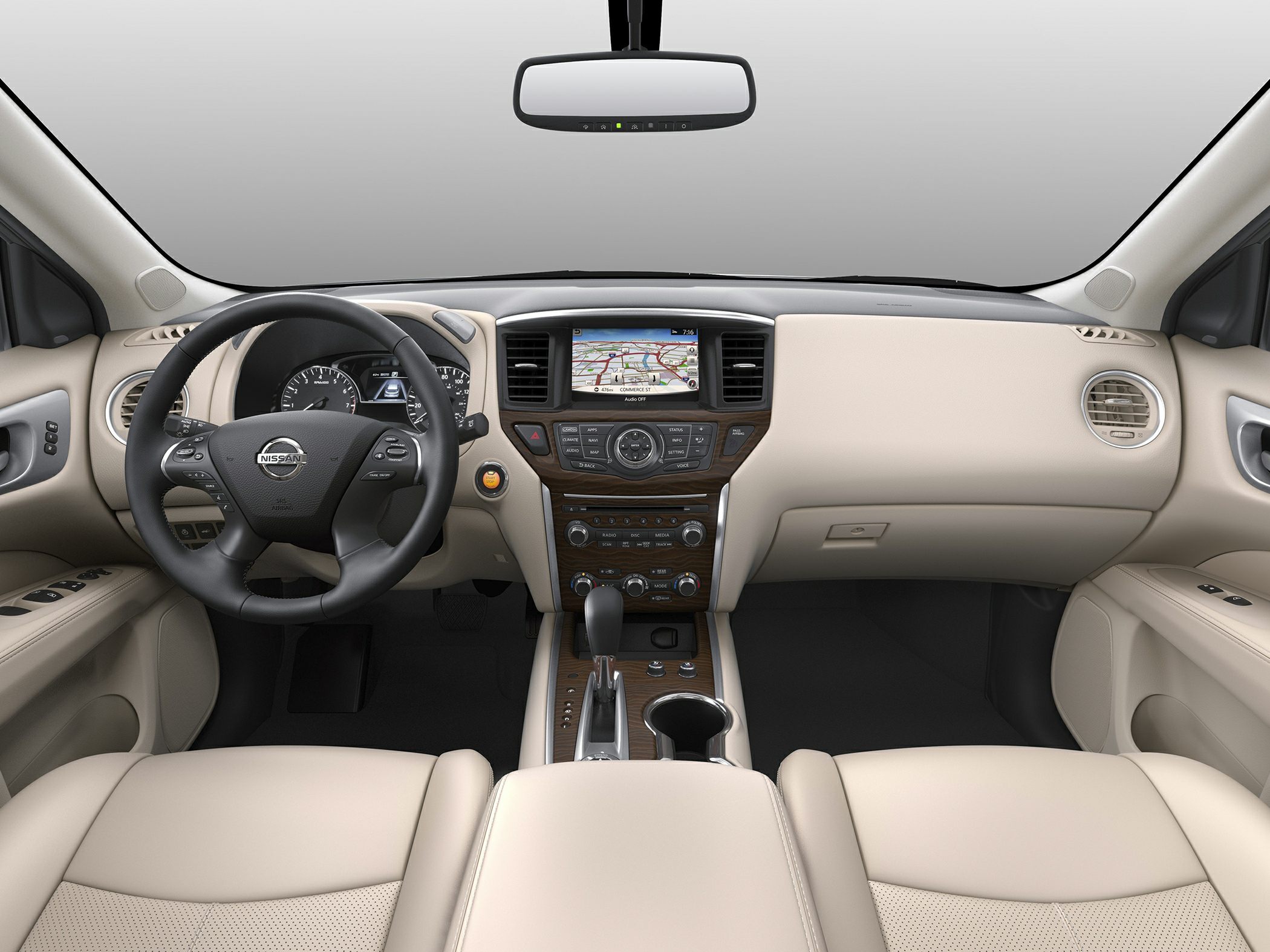
Also available are heated and cooled front seats, heated steering wheel, heated second-row seats, power tilt and telescoping steering wheel, 13-speaker Bose Audio, tri-zone automatic climate control and remote engine start.
The Pathfinder’s audio and climate controls are far easier and less distracting to use than those in some competitors. Similarly, the transmission gear selector is a traditional shift lever rather than ditzy buttons or some trick electronic joystick, but there are no paddles or other provision for the manual selection of gear ratios. On four-wheel drive models, a simple knob behind the shift lever allows a choice of front-wheel drive or four-wheel drive and four-wheel drive lock, with a button for hill-descent control.
When it comes to utility and convenience, the Pathfinder is still one of better bets in this segment. The interior materials mostly look and feel expensive. There are soft-touch surfaces in all the places you expect and want them, and the seats are comfortable and supportive. The design of the interior feels modern and surpasses many rivals.
Nissan makes a good case for the Pathfinder as a family hauler with some undeniably convenient features, such as a 60/40-split, tilt-and-glide second-row seat that eases access to the 50/50-split third-row even with a child safety seat in place on the passenger side. The 16-cubic-feet of storage behind the third row isn’t remarkable, but with that row stowed, cargo space grows to nearly 50 cubic feet, among the best in its class.
Second Step Forward
You’ll need to pop the hood to discover the 2017 Pathfinder’s second, and perhaps the biggest step forward. The 3.5-liter V-6 was tweaked and gets direct fuel injection, a revised air intake, new pistons, variable intake-valve timing and a higher compression ratio. It now spins out a healthy 284 horsepower at 6,400 rpm and 259 pounds-feet of torque at 4,800 rpm, which renders a zero-to-60-mph time of 7.3 seconds. Yet fuel economy remains the same, scoring 20-mpg city/27 highway/23 combined EPA fuel-economy ratings with front-wheel drive, one mpg less with available all-wheel-drive—ratings that are near the top of the class.

Hill start assist is standard, hill descent control comes with all-wheel-drive, and the third-generation Xtronic CVT transmission’s DStep Logic Control simulates the feel of a conventional geared automatic.
The extra engine output improves towing capacity. The 2017 Nissan Pathfinder is now rated at a beefy 6,000 pounds, among the highest in its class. When equipped for towing, the Pathfinder has trailer sway and other controls built-in.
On the Road
Our 2017 Nissan Pathfinder Platinum 4-Wheel Drive was loaded with every feature Nissan has to offer. With a sticker price of $44,685, including a $900 destination charge, it seemed almost a bargain.
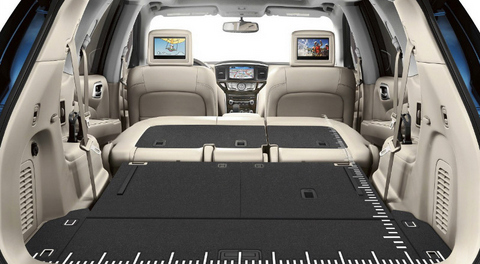
Visibility out the front and sides is great, but rearward visibility was somewhat limited with the third row in place due to the high head rests, one of the few complaints I had as the Pathfinder ate up 820 miles covering a wide variety of roads and highways. Thankfully all models come with a rear-view camera; our Platinum model offered up a surround-view camera with motion detection, which was much appreciated in shopping center parking lots.
There’s no hiding the size of the Pathfinder. It’s a big, three-row galleon, and the revised suspension is tuned for soaking up bumps and bridge connections, while dispatching speed humps with relative ease. That ride comfort, coupled with very comfortable seats, means it’s a big check in the box of urban driving. The low-down torque of the V-6 engine was enough to make it quite zippy around town and the crossover never felt slow or lacking power.
Heading out through winding, sweeping country roads, the flexibility of the engine became evident. It had enough pep to move with pace and the stepped function of the CVT worked well to make it feel more like a torque converter. The Pathfinder is among the most agile in its near full-size, three-row crossover class without being so softly sprung that body roll is a problem. It flowed nicely through bends and had more than enough power for merging and overtaking onto freeways. In the fast lane, the cushy, quite ride mimicked a 1980s-American-sedan.
A revised steering provided a welcome measure of additional heft and responsiveness. Brake pedal feel was confidant, and I wasn’t overwhelmed when I needed to stop quickly when an idiot ran a red light.
The 4WD Story
In terms of four-wheel drive equipment, the Pathfinder isn’t quite the rough and tumbled off-roader it replaced. But, it manages to do well with the equipment it has. Featuring an intelligent on-demand four-wheel drive system, it runs in front-wheel drive until it needs to send torque to the rear, which provides a reassuring feeling when driving on snow or ice-pack roads.
Off the road, a manually lockable center differential adds traction when needed. Serious four-wheel enthusiasts will not look to the Pathfinder to get their kicks, but for the occasional off-roader who just wants to get the family to the more remote lakeside, it will definitely do the job.
As for real world fuel economy, our 2017 Pathfinder Platinum 4WD averaged 24.2 mpg for the 820 miles. That’s right at the top for the class with the exception of Toyota’s Highlander Hybrid, which has an EPA estimate of 28 mpg city/highway combined.
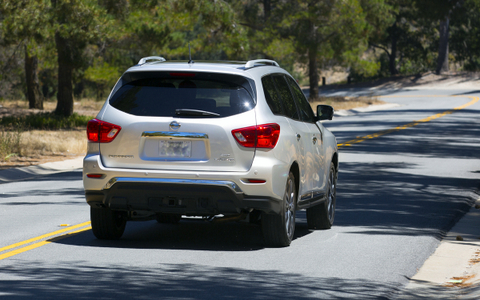
The Three-Row Crossover SUV For You?
My oh my, there’s a lengthy list of three-row crossover SUVs to choose from (and because of their overall dismal fuel economy, they are not the vehicles Clean Fleet Report normally pursues, which is why we haven’t covered the Ford Flex, Volkswagen Atlas, Kia Sorento, Mazda CX-9, Honda Pilot, Chevrolet Traverse, Hyundai Santa Fe, Dodge Durango, Toyota Highlander, among others). The only way to make a choice is to dig in, do research and spend a few Saturdays test driving your selections. Take your kids along and let them climb in and out of the second and third rows. If you have a wee one, take a car seat to see how easy or not easy it is to install. For a thorough evaluation, including at least a two-hour test drive, expect to spend around three hours at a dealership.
As for the 2017 Nissan Pathfinder, the new old school-like SUV styling may not be for you. However, if it is, impressive power, pleasant handling, high tech galore and an inviting personality might just be strong enough to sway you.
Related Stories You Might Enjoy:
News: 2018 Lexus RX 450hL Crossover Adds Third Row of Seats
Top 10 Best MPG AWD SUVs/Crossovers
Road Test: 2014 Toyota Highlander Hybrid
Road Test: 2017 Mitsubishi Outlander
Road Test: 2016 Nissan Rogue
Disclosure:
Clean Fleet Report is loaned free test vehicles from automakers to evaluate, typically for a week at a time. Our road tests are based on this one-week drive of a new vehicle. Because of this we don’t address issues such as long-term reliability or total cost of ownership. In addition, we are often invited to manufacturer events highlighting new vehicles or technology. As part of these events we may be offered free transportation, lodging or meals. We do our best to present our unvarnished evaluations of vehicles and news irrespective of these inducements.
Our focus is on vehicles that offer the best fuel economy in their class, which leads us to emphasize electric cars, plug-in hybrids, hybrids and diesels. We also feature those efficient gas-powered vehicles that are among the top mpg vehicles in their class. In addition, we aim to offer reviews and news on advanced technology and the alternative fuel vehicle market. We welcome any feedback from vehicle owners and are dedicated to providing a forum for alternative viewpoints. Please let us know your views at publisher@cleanfleetreport.com.

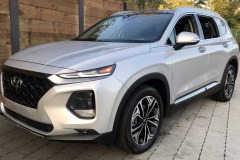

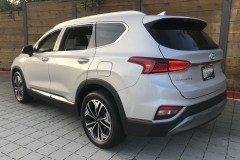
13 thoughts on “Road Test: 2017 Nissan Pathfinder Platinum 4WD”